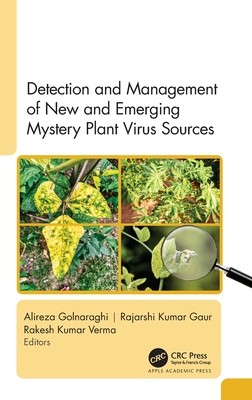
- We will send in 10–14 business days.
- Publisher: Apple Academic Press
- ISBN-10: 1774916622
- ISBN-13: 9781774916629
- Format: 15.6 x 23.4 x 1.9 cm, kieti viršeliai
- Language: English
- SAVE -10% with code: EXTRA
Detection and Management of New and Emerging Mystery Plant Virus Sources (e-book) (used book) | bookbook.eu
Reviews
Description
Plant virus infections are estimated to cost billions of dollars in economic losses. Despite intensive efforts to manage and prevent plant viruses and their potential vectors in crop production processes, the threat posed by newly emerging or re-emerging viruses is becoming more common and poses potential threats even in previously uninfected areas. Viral outbreaks in plants are a pressing issue that causes loss of crops and harvest on a mass scale. In this volume, the editors took on the very important task of reviewing the progress made and the challenges ahead to address the hidden world of plant viruses, their impact on agriculture and food security, and the need for new detection systems and management strategies.
Divided into two sections, the volume presents recent approaches for plant virus detection and explores new trends in viral disease control. The first part details advances in detection strategies and diagnostics of plant viruses and new and recent trends in diagnostic methods, such as next-generation CRISPR-based diagnostic methods, among other current and prospective strategies for plant virus detection. Taking into consideration the biological and anthropogenic risk factors favoring persistence and spread of harmful plant viruses, the second part provides an in-depth look at recent trends in viral disease control and management. It explores the conventional versus modern techniques, including a CRISPR/Cas system-mediated adaptive immunity approach, as well as other specific plant virus control tools.
Overall, this book, Detection and Management of New and Emerging Mystery Plant Virus Sources, will prove a valuable resource regarding the detection and management techniques of plant viruses. It will thus be particularly useful for research scholars, scientists, professors as well as students in the field of plant or environmental viruses.
EXTRA 10 % discount with code: EXTRA
The promotion ends in 21d.05:40:25
The discount code is valid when purchasing from 10 €. Discounts do not stack.
- Publisher: Apple Academic Press
- ISBN-10: 1774916622
- ISBN-13: 9781774916629
- Format: 15.6 x 23.4 x 1.9 cm, kieti viršeliai
- Language: English English
Plant virus infections are estimated to cost billions of dollars in economic losses. Despite intensive efforts to manage and prevent plant viruses and their potential vectors in crop production processes, the threat posed by newly emerging or re-emerging viruses is becoming more common and poses potential threats even in previously uninfected areas. Viral outbreaks in plants are a pressing issue that causes loss of crops and harvest on a mass scale. In this volume, the editors took on the very important task of reviewing the progress made and the challenges ahead to address the hidden world of plant viruses, their impact on agriculture and food security, and the need for new detection systems and management strategies.
Divided into two sections, the volume presents recent approaches for plant virus detection and explores new trends in viral disease control. The first part details advances in detection strategies and diagnostics of plant viruses and new and recent trends in diagnostic methods, such as next-generation CRISPR-based diagnostic methods, among other current and prospective strategies for plant virus detection. Taking into consideration the biological and anthropogenic risk factors favoring persistence and spread of harmful plant viruses, the second part provides an in-depth look at recent trends in viral disease control and management. It explores the conventional versus modern techniques, including a CRISPR/Cas system-mediated adaptive immunity approach, as well as other specific plant virus control tools.
Overall, this book, Detection and Management of New and Emerging Mystery Plant Virus Sources, will prove a valuable resource regarding the detection and management techniques of plant viruses. It will thus be particularly useful for research scholars, scientists, professors as well as students in the field of plant or environmental viruses.


Reviews